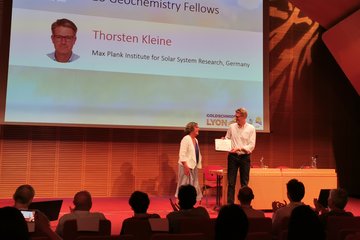Alle Typen
161.
Vortrag
Cluster observations in radiation belts and ring current. 27th Cluster Workshop, Bled, Slovenia (2017)
162.
Vortrag
Analysis of RAPID electron fluxes after corrections for the long-term detector decay. 23th Cluster Cross-Calibration Meeting, Mallorca, Spain (2017)
163.
Vortrag
CLUSTER view on PSBL ion beams in the Earth's magnetotail. 4th Cluster-THEMIS workshop, Palm Springs, USA (2016)
164.
Vortrag
Signature of solar wind turbulence in the ground magnetic field and its relation to ion acceleration. European Geosciences Union General Assembly, Vienna, Austria (2016)
165.
Vortrag
Characterization of energetic O+ and H+ ions in the plasma sheet. 4th Cluster-THEMIS workshop, Palm Springs, USA (2016)
166.
Vortrag
Dispersionless injections at geosynchronous orbit during a substorm event. ISSI team meeting, Bern, Switzerland (2016)
167.
Vortrag
Energetic particles and chorus waves during injections. ISSI team meeting, Bern, Switzerland (2016)
168.
Vortrag
Control of oxygen ion acceleration by turbulence. Cluster 15th and Double Star 10th anniversary workshop, Venice, Italy (2015)
169.
Vortrag
On the dayside high altitude stagnant region of cold ion outflow. Cluster 15th and Double Star 10th anniversary workshop, Venice, Italy (2015)
170.
Vortrag
Long-term analysis of cosmic ray background seen by the RAPID electron detector on Cluster. Geospace Revisited: a Cluster/MAARBLE/Van Allen Probes Conference, Rhodes, Greece (2014)
171.
Vortrag
Status report of the RAPID instrument on board Cluster. Geospace Revisited: a Cluster/MAARBLE/Van Allen Probes Conference, Rhodes, Greece (2014)
172.
Vortrag
Oxygen ion outflow from the magnetosphere. (2014)
173.
Poster
Calibration of RAPID/IES 3D electron data: detector-to-detector corrections and long-term degradation. 29th Cluster workshop, Lanzarote, Canary Islands, Spain (2019)
174.
Poster
Prediction of soft protons in the near-Earth space using machine learning. Machine Learning in Heliophysics, Amsterdam, Netherlands (2019)
175.
Poster
Acceleration of plasma in current sheet during substorm dipolarizations in the Earth’s magnetotail: comparison of different mechanisms. EGU General Assembly, Vienna, Austria (2019)
176.
Poster
Electron Intensity Measurements by Cluster Mission in Radiation Belts of the Earth. EGU General Assembly, Vienna, Austria (2019)
177.
Poster
RAPID detection of heavy ions in the magnetosphere. 5th Cluster-Themis Workshop, Chania, Greece (2018)
178.
Poster
Update on the long-term calibration of RAPID/IES 3D electron data. 5th Cluster-Themis Workshop, Chania, Greece (2018)
179.
Poster
Dynamics of suprathermal electron and proton fluxes during magnetotail dipolarization associated with magnetic flux pile up in the near-Earth plasma sheet. European Geosciences Union (EGU) General Assembly 2018, Vienna, Austria (2018)
180.
Poster
Plasma acceleration on multiscale temporal variations of electric and magnetic fields during substorm dipolarization in the Earth’s magnetotail. European Geosciences Union (EGU) General Assembly 2018, Vienna, Austria (2018)











